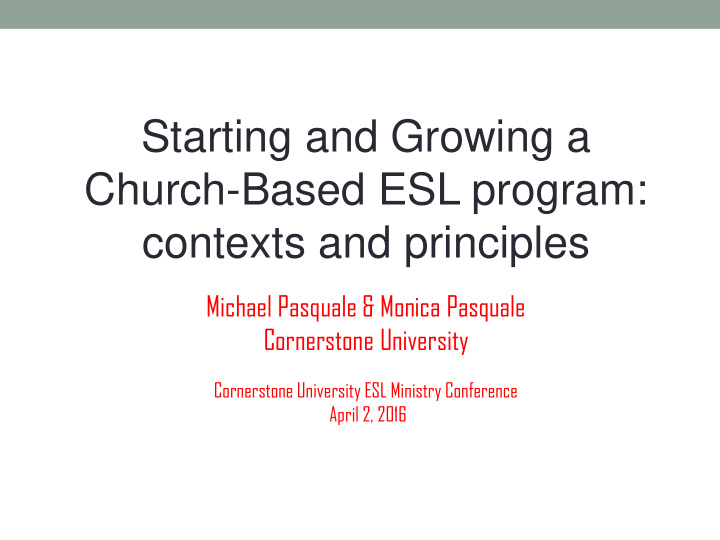



Starting and Growing a Church-Based ESL program: contexts and principles Michael Pasquale & Monica Pasquale Cornerstone University Cornerstone University ESL Ministry Conference April 2, 2016
DEVELOPING A MINISTRY- FOCUSED ESL PROGRAM Part One
#1 – Be Ethical Two accusations against Christians in ESL: 1) Lack of preparation 2) Lack of transparency of motives in using ESL for evangelistic purposes
#2 – Be Hospitable Hospitality – over-arching characteristic of hospitality is love, How to show hospitality, … • Be sensitive to needs … • Learn the language of your students, …
#3 – Be Prayerful • Prayer is vital … • Pray for your students, … • Pray for your fellow teachers, … • Involve church- wide prayer support, …
Part Two STEPS TO DEVELOP AN ESL PROGRAM IN YOUR CHURCH
Is ESL a useful tool for your church? • What is the location and demographics of the people in the surrounding area of your church? • What is the makeup of your congregation? • Are other ESL classes offered by churches or programs in the community?
How to plan an ESL program • Define your mission • Find a capable administrative director • Find a strong lead teacher(s) • Recruit a team of teachers
How to plan an ESL program • Select and order curriculum • Decide upon the duration of classes • Determine whether you will charge • Provide orientation and training opportunities for teachers • Advertise the classes • Pre-register students
How to conduct and ESL class • Establish class levels • Plan for child care • Consider transportation issues • Plan a brief time for announcements and prayer • Distribute a basic information sheet • Maintain flexibility
How to conduct an ESL class • Plan time for refreshments and fellowship • Follow the classes with teacher debriefing and prayer • Provide social service information • Plan a party
Developing and sustaining an ESL program • Build a budget • Provide continued discipleship and mentoring • Provide cultural awareness training for your own congregation • Incorporate cross-cultural elements into all aspects of the church • Invite your congregation to be a part of the ministry
Part Three DEVELOPING A COMMUNICATIVE ESL CLASSROOM
ESL Teaching & Learning Principles ESL teaching and learning principles will help guide you in making choices concerning what books to use, how to prepare for a class, etc.
ESL Teaching & Learning Principles Be prepared pared to teach ch the ABCs Cs The teacher must be prepared for each ESL session, understand a student’s a ttitude or motivation for learning English, encourage them to b e diligent in study, and encourage students to c ommunicate in English.
Diligence …language learning takes time • Daily interaction with English is necessary to gain proficiency • FSI survey … # of hours needed for native English speakers to gain proficiency in speaking and reading in another language: • Closely related languages (e.g. Spanish): 575 to 600 class hours. • Significantly different languages (e.g. Russian): 1100 class hours • Exceptionally difficult (e.g. Chinese): 2200 class hours
Recommend
More recommend